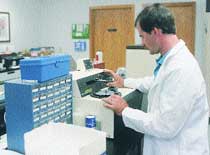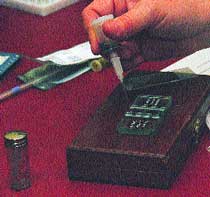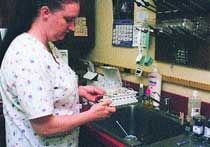Regular testing can serve as early prevention tool
Dr. Johnny Hoskins tackles some of the common errors made in diagnostic testing and the importance of regular testing in aging pets.
In a recent local meeting, a fellow veterinarian said 20 years ago a lot more simple things entered the veterinary practice door. Today, the majority of the dogs and cats entering the veterinary practice are sick and require immediate point-of-care. Is your veterinary practice moving toward greater point-of-care capabilities?

To provide clients with the highest quality of care for their pets, veterinarians should make regular diagnostic testing a mainstay in their practices, especially for aging pets that can have notable medical changes in just a few months.
Immediate point-of-care starts with the mainstays of any veterinary practice - hence, collection of accurate case history followed by performing a thorough physical examination. Thereafter, samples are collected for performing a CBC, serum chemistry profile and urinalysis. Results obtained from the case history, physical examination and laboratory tests (CBC, serum chemistry profile, and urinalysis) are then used to determine additional diagnostic needs. There are several common practical errors associated with regular diagnostic testing that occur in most veterinary practices (Table 1). For example, a common practical error is performing radiography and/or ultrasonography before the case results of the CBC, serum chemistry profile, and urinalysis are known.
Effects of biological factors
Many biological factors, such as breed, age, gender and body condition score, influence the results of serum chemistry profile tests. Young dogs and cats tend to have a lower PCV, BUN and serum total protein value and a higher serum ALP, total bilirubin and phosphorus value than established as the normal range. Similarly, older healthy dogs and cats tend to have decreases in the BUN, serum GGT, and serum creatinine value and increases in serum total protein and potassium value. Other biological factors involve those that can be controlled when drawing the blood sample, such as ensuring the animal is properly fasted. Non-biological factors are those related to sample collection and handling, such as choice of anticoagulant used and UV-light exposure.

Table 1: Practical Errors Commonly Made in Regular Diagnostic Testing
More veterinary practices today use in-house automated chemistry analyzers or send samples daily to commercial veterinary reference laboratories. In-house testing provides results more quickly and at more flexible times than if tests are performed at commercial veterinary reference laboratories. Estimates of the percentage of samples collected in veterinary practice that are compromised by the presence of hemolysis, lipemia, icterus, or other substances such as medications ranges from 50 percent to 80 percent. The impact of these interferences on serum chemistry profile results depends, in part, on the analyzer and methods used. The specific impact on a serum chemistry test result will differ depending on the type of instrumentation.
High body condition scores
Obese cats (i.e., high body condition scores) tend to have a higher than normal hematocrit. The serum concentrations of cholesterol and triglycerides are significantly increased in obese cats and dogs. It is interesting that fasted serum glucose concentrations are not usually increased in the obese cat or dog. As cats become obese, serum free thyroxine (FT4) by dialysis increases in the normal range and correlates with most indices of obesity, whereas serum total thyroxine (TT4) and total triiodothyronine (TT3) concentrations do not change significantly.
Liver and gall bladder evaluation
The common serum chemistry profile tests for liver and gall bladder disease include the serum leakage enzyme tests (ALT and AST) and the cholestatic tests (ALP and GGT). Other tests for liver function include serum total bilirubin, bile acids, albumin, globulin and cholesterol. Following liver parenchymal injury, serum ALT increases followed by serum AST. Serum AST returns to normal more rapidly than serum ALT provided there is no added muscle tissue damage. Chronic liver disease is likely if serum ALT and AST both remain increased. Cholestasis can result from impaired bile flow or can be drug-induced (increased glucocorticoid concentration and administration of anticonvulsants). Serum ALP and GGT are normally present in low concentrations. Impaired bile flow stimulates production of ALP and may also be linked to retention of bile acids.
Bile acids are stored in the gall bladder and then released into the intestinal tract. Most bile acids are actively resorbed in the ileum and carried to the liver where they are re-conjugated and excreted as part of the enterohepatic circulation of bile acids. When functional hepatic mass is reduced extraction of bile acids from blood is affected. Measurement of serum bile acid concentrations is, therefore, a good indicator of hepatobiliary function. Increased serum bile acid concentrations, however, are not specific for the type of underlying liver disease. Other factors independent of hepatobiliary function that may affect serum bile acid concentrations are decreased gastrointestinal transit time and spontaneous gall bladder contraction. Prolonged fasting, intestinal malabsorption, or increased intestinal transit time through the intestine (e.g. diarrhea) can lower serum bile acid concentrations.

Practical errors are commonly made when diagnostic testing is done. It is important to train staff to avoid making these errors which could have an impact on an accurate diagnosis.
Kidney evaluation
Nearly all blood constituents pass through the renal glomeruli and enter the tubules. Kidney injury may result in an inability of the glomerulus to retain cells and proteins or impair the resorptive capability of the tubules. Azotemia (i.e., increased BUN and serum creatinine) occurs when any condition alters the glomerular filtration rate or when the urinary tract is obstructed. Nutritional status and gastrointestinal hemorrhage will also affect BUN concentrations. Because creatinine is formed during normal muscle metabolism, the amount of creatinine present is affected by the animal's total muscle mass. An alteration in the ratio of the BUN-to-creatinine concentrations is a more significant indicator of renal disease than individual measurements of either component. If in question about actual renal function for the older dog or cat, an iohexol clearance test that measures glomerular filtration rate may also be used.
Pancreatic evaluation
Serial determinations of serum amylase in conjunction with serum lipase provide the best practical indication of pancreatic function. Amylase is produced in a variety of tissues including the salivary glands, small intestine, and pancreas. Most serum lipase is derived from the pancreas. Excess serum lipase is easily filtered through the kidneys so serum lipase concentrations tend to remain normal in early stages of pancreatic disease. Gradual increases may be seen as pancreatic disease progresses. In chronic pancreatic disease, damaged pancreatic cells are replaced with connective tissue that cannot produce pancreatic enzyme. This information all sounds good, but the most common reason for increased serum amylase and lipase in older dogs and cats is intestinal disease and not pancreatitis.
Glucose evaluation
Blood glucose measurements provide a useful indicator of the pancreatic islet cells activity. Traditional glucose test methods have high degrees of interferences, especially in hemolyzed, icteric or lipemic serum samples. Serum fructosamine concentration is a more specific indicator of pancreatic islet cells activity than is blood glucose concentration. Fructosamine, a glycosylated serum protein, provides an indication of the average blood glucose concentrations during the previous one to three weeks.
Glucose binds to hemoglobin and produces glycosylated hemoglobin. Increased blood glucose concentrations increase the binding of glucose to hemoglobin that results in an increased glycosylated hemoglobin value. The glycosylated hemoglobin concentration is then an indication of the average glucose concentrations during the lifespan of erythrocytes. Since erythrocyte lifespan is approximately 120 days in dogs and 65 days in cats, the glycosylated hemoglobin concentration is a reflection of average glucose concentrations during the preceding three to four months in dogs and two to thre months in cats. Thus, glycosylated hemoglobin is an indicator of the blood glucose concentration during a longer period of time than is either a single blood glucose measurement or fructosamine concentration.

In-house automated chemistry analyzers are being used more frequently in most veterinary practices. These in-house tests provide quicker results and allow for more flexibility. However, there is also more chance for errors to occur because of the method used or the analyzer. To avoid errors, staff members must observe all protocols when performing in-house testing and be familiar with how to use the equipment.
Tests for urinary ketone bodies may also be used for monitoring insulin therapy in diabetic dogs and cats. However, in some animals with diabetic ketoacidosis no urinary ketone bodies are detected, because the commonly used urinary tests for ketone bodies detect only acetone or acetoacetate.
Older dogs and cats entering the veterinary practice today are sick and require immediate point-of-care. Immediate point-of-care begins with collection of accurate case history followed by performing a thorough physical examination. Thereafter, samples are collected for performing a CBC, serum chemistry profile, and urinalysis. Results obtained from the case history, physical examination, and laboratory tests (CBC, serum chemistry profile, and urinalysis) are then used to determine additional diagnostic needs. Regular diagnostic testing is a necessary part of the immediate point-of-care in older dogs and cats.
Suggested Reading
- Ferguson DC, Holson J, Caffall Z, et al: Influence of obesity on serum total and free thyroid hormone concentrations in cats. ESVIM Meeting, Dublin, 2001; p. 117.
- Hoenig M: Interpretation of laboratory results in obese cats. Proceedings, 20th Annual Forum ACVIM, Dallas, 2002; p. 591.
- Willard M D, Tvedten H, Turnwald GH: Small Animal Clinical Diagnosis by Laboratory Methods, 3rd edition. Philadelphia, WB Saunders, 1999.